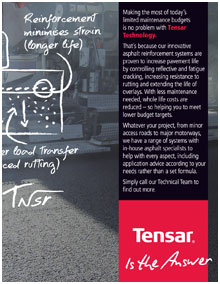eNews
Issue 5 | Winter 2011
Clients' view
Highway Maintenance Efficiency Programme (HMEP): An update
Matthew LuggChair of Workstream 1
Seconded to Department for Transport
HMEP is a £6m Government funded programme to deliver efficiencies across the highway maintenance sector. Since the launch in April the last six months of HMEP has been a busy period of mobilising resources to get the Efficiency Programme off the ground and we are now up and running on all four cylinders!
A crucial first step of work for my Workstream 1 was to gather information about the sector through a comprehensive survey of English highway authorities specifically in relation to five of the work packages, principally around procurement. The overall response rate of 55% was brilliant with the headline results providing a clear mandate for much of the work we are undertaking.
These include clear support for NEC as the standard form of contract, 95% of respondents supported a standard specification (crucial for driving down the costs of highway maintenance commodities and services) and a clear appetite from the sector to develop further collaborative alliances similar to the Midland Highway Alliance (MHA) and the South East 7 (SE7). The survey has also provided clear evidence of the potential overall benefits realisation of the products and toolkits to support procurement.
Jason Russell (Surrey CC) who leads Workstream 2 is also making excellent progress particularly with regard to supply chain re-engineering, from the knowledge transfer of the Highways Agency and property sector. He is currently working with both the SE7 and the Association of Greater Manchester Authorities (AGMA).
Recognising the importance of having base line information to benchmark cost and bring performance and quality Steve Kent (Cheshire West and Chester), the Lead for Workstream 4, is overseeing the development of CQC (Customer/Quality/Cost) process building on the widely supported public satisfaction survey undertaken by NHT Surveys
The pothole review has also recently reached a key milestone with the completion of an interim progress report for the Minister for Transport Norman Baker. This report will focus on the key lines of enquiry agreed by a broad stakeholder group including road user groups, industry, utilities, local and central government. Some of the highlights:
- To review and update best practice for pothole repairs
- Identify what we can learn from organisations that engage with the public effectively
- The benefits of asset management in reducing potholes
- Preventative maintenance – the types of material and the optimum time to intervene (inevitably including surface treatments)
Construction Products regulations for Surface Treatments of Road Services
C G LewisTechnical Director, BSI Product Certification
The Construction Products Directive (CPD) was implemented in 1991 and this required all construction products sold within Europe to comply with harmonised European standards and carry the CE mark.Within the UK however, whilst it was mandatory for construction products to comply with the CPD, it wasn’t mandatory that the products were actually marked with the CE mark. This potentially resulted in some companies ignoring the directive (unless they exported their products to Europe) and not taking the necessary steps.
Why do UK organisations need to comply now?
A European Regulation unlike a Directive automatically becomes law in every member states and companies in the UK must now comply with the Regulations, have an appropriate EC Certificate and mark their products with the CE mark.The Construction Products Regulations (CPR) came into operation in April 2011 with the enforcement date by which companies need to comply being 30th June 2013. Whilst this is a long way off organisations need to start the process now in order to comply in time.
How do Surface Treatment organisations comply?
They will need to comply with the ZA Annex either the standard for Surface Dressing BS EN 12271 and/or the standard for Slurry Surfacing BS EN 12273.
For organisations certified to the National Highways Sector Scheme 13 they will have completed a number of Type Approval Installation Trials (TAIT) and introduced a Factory Production Control system and consequently they should have undertaken all the steps they need to do other than applying to a notified body such as BSI for an EC Certificate of Factory Production Control.
For other organisations, they will have to either undertake their own TAITs or if the system they are using has been covered by a TAIT they can cascade this information from a System Designer. They will also need to implement an FPC system. They will then need to apply to a notified body for assessment and certification. The notified body will assess the organisations system for surface treatment in the office and on site and trace the product back to the TAIT. There is no certification of the TAIT by a notified body
Once an Organisation has their EC Certificate they will need to produce their own Declaration of Performance.
How can BSI Help?
BSI has the widest scope of all Notified Bodies and we can help clients conform to the Regulations.
ROAD MAINTENANCE – THE VIEWS OF THE AA
Paul WattersHead of Roads Policy, Automobile Association
In a dramatic turnaround from three years ago, the condition of the roads now beats the cost of motoring as the top motoring concern of the AA’s 15 million members. In July 2008, 55% of AA members, in an AA/Populus panel poll, listed the cost of motoring as their No 1 concern, with only 11% most concerned by the state of the roads. In August 2011, 42% listed road condition as their biggest worry while the cost of motoring most concerned 19% of the sample.
This concern about road condition is borne out by another AA Populus poll carried out at the start of 2011 which showed that 81% of AA members think the roads have deteriorated in the last three years with 57% of respondents saying conditions had deteriorated significantly and almost a quarter saying conditions had deteriorated slightly. Only 1% thought conditions had improved considerably and 6% thought they showed slight improvement. 12% of those who responded thought conditions were unchanged.
The three successive bad winters have certainly taken their toll of the UK’s roads and despite £300m emergency funding the damage has highlighted the precarious state of the UK’s biggest transport asset its roads. The UK’s road network is a multi billion pound asset and yet its maintenance seems to be regarded as a secondary concern by politicians wrestling with other priorities. Yet the vast majority of goods and people need roads to go about their daily business.
The post-winter pothole blight, whilst unwelcomed, has fortunately driven the issue of road maintenance higher up the political agenda and deservedly so. However, there is a real risk that political interest will quickly wane as attention reverts to the public finances and budget savings once again. It would be economic madness to let the roads fall apart. Not only would that be inconvenient to drivers it will probably lead to huge and unnecessary extra costs in patching and repairing them let alone the very real risk of more accidents due to their poor condition.
The 2010 English Road Condition Report has already identified that a quarter of main roads do not meet initial skid resistance standards and require further investigation, in London this is 49%. Pot holes are very visible to drivers and high profile in the media and politics. However, the failing fabric of many others roads and the quality of surfaces is less clear to see but just as dangerous. We need constant high profile pressure for road maintenance to get the funding it deserves if we are to properly look after this absolutely vital asset for the next generation.
back to contents »
Copyright 2011 Road Surface Treatments Association. www.rsta-uk.org





